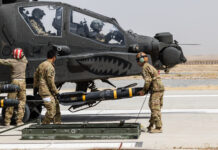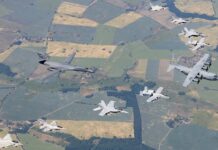France has long recognised the importance of a highly capable national defence industry as it provides France with ‘strategic autonomy’, meaning that it can meet a substantial part of its own defence needs without dependence upon external suppliers.
This also provides a positive economic impact through expenditure in the domestic economy. The fact that aerospace and defence is a high technology industry raises the technology level of French industry as a whole, thus making it more competitive and successful in a global context.
A Diplomatic Tool
The significance of the French industry goes far beyond ‘strategic autonomy’ and domestic economic impact. Internationally, the strength of the French industry provides Paris with an extremely important diplomatic tool to meet its foreign policy objectives and exert its influence. Then there are the economic implications. Exports sustain the French defence industrial base and its workforce, contribute to the cost of defence research and development and provide a welcome influx of funding to the benefit of France’s balance of payments thus boosting the health of the national economy.
How important is the French industry in an international context? According to the Stockholm International Peace Research Institute (SIPRI) in its Fact Sheet of March 2022, France remains one of the major defence exporting countries. SIPRI data lists the top ten defence exporting countries from 2017 to 2021 as follows:
- United States
- Russia
- France
- China
- Germany
- Italy
- United Kingdom
- Republic of Korea
- Spain
- Israel
Using SIPRI figures between 2017 and 2021, French defence exports accounted for 11 per cent of the global total. This 2017 to 2021 total marked a 59 per cent increase compared to the level of exports achieved between 2012 and 2016. SIPRI stated that in the 2017 to 2021 period, 47 per cent of French exports went to Asia and Oceania and 37 per cent to the Middle East. Aircraft made up for 56 per cent total defence exports, with ships accounting for 15 per cent.
SIPRI data has France delivering defence equipment to 65 different countries between 2017 and 2021, with the three largest markets being India, Qatar and Egypt who together accounted for 56 per cent of French defence exports in this period. India was a key market for France; it was the destination for 29 per cent of French defence exports. SIPRI states that, “France’s arms exports to India in 2017-21 were almost 11 times higher than in 2012-16 and reached their highest level for any five-year period since 1950.” Turning to Qatar, SIPRI figures indicate that French defence sales to Qatar were 25 times higher in 2017 to 2021 than in 2012 to 2016.
The primary driver of French defence export success, according to SIPRI, has been the Dassault RAFALE. Between 2017 and 2021, India received 54 RAFALE, Qatar 30 and Egypt 18, a total of 102 aircraft. In 2021 orders were received for 188 aircraft:
- Croatia (12)
- Egypt (30)
- Greece (24)
- Indonesia (42)
- the UAE (80)
Without question, RAFALE has transformed the fortunes of French defence exports and its success has opened the way for increased business in these major markets.
Global Footprint
The best picture of the French defence industry can be gained from looking at a 2021 MoD report submitted to the French Parliament titled “Rapport au Parlement 2021 sur les exportations d’armement de la France”. The report provides a country-by-country breakdown in millions of euros of French defence exports and it includes financial data from 2011 through to 2020. Euro costs are denominated at current value as of 2021. It should be noted that the 2022 version of the “Rapport au Parlement sur les exportations d’armement de la France,” is in preparation at the time of writing and this will include defence sales figures for 2021.
Looking at the figures, it is clear that defence exports continue to make a major contribution to French export numbers. The two key market areas for France are the Middle East and South Asia, confirming the SIPRI data sets discussed earlier. Then comes the EU region in third place, with the French government and industry looking to increase sales and market in that region if they possibly can. After the EU region, in fourth place is Southeast Asia and then comes non-EU Europe as the fifth most important defence market for France. One would imagine that sales post-2020 will be boosted in EU Europe by RAFALE sales and naval sales to Greece, with Southeast Asia sales boosted by the RAFALE victory in Indonesia. Despite this, there is ample evidence that the Middle East and South Asia marketplaces remain as the two leading export territories for French industry post-2020.
A Question of Economics and Money
The world that existed on the first day of January 2022 is no more. All of the foward-looking statements that existed at that point in the context of politics and economics now have little relevance. The same is true of defence both in terms of national defence and security requirements and also the situation of national defence industries. Unfortunately, everything has turned out worse than expected in early 2022 and there are very few indicators that the global economic situation will improve across the remainder of the year.
The impact of the human tragedy caused by COVID is one aspect of the problem. The actions taken to combat COVID roiled countries around the world, causing massive economic disruption, exorbitant increases in government spending, the disruption of global supply chains, rising oil and gas prices, inflationary trends. In early 2022, there were hopes for signs of economic growth and concrete action to recover the global economy. Instead, there was a war in Europe, and the Russian invasion of Ukraine this February dashed any hopes of a global economic recovery.
While in February Moscow may have dreamed of a short, victorious war, the fact as of August Ukraine was still fighting, and the horrendous losses in personnel and materiel on both sides, indicate that the conflict will continue for the foreseeable future. Ultimately, it will come down to the staying power of the combatants, and at the moment there are no signs that either side is seeking a peaceful resolution.
Before the invasion, France had desperately tried to find a diplomatic solution but the diplomatic approach failed. For our consideration, the impact of the conflict on the economic situation of the French government and the consequences for French defense policy and the French defense industry are of importance. The global economic picture was not positive prior to February 2022 but since then, matters have only gotten worse. As far as France was concerned, cautious optimism prevailed at the end of 2021. Although the French economy had contracted by eight percent in 2020, the economy had grown by seven percent in 2021. France is the seventh-largest economy in the world and the second-largest in the euro zone after Germany. However, the French economy was no protection against the systemic shocks that would hammer European economies.
Wider Problems
Rising energy costs are a damaging factor for the French economy. Rising costs and limited supplies of fertilizers are also damaging, as agriculture is a major industry in France. All of this contributes to the inflationary pressures France is beginning to face. Inflation in France was 6.1 per cent in July, up from 5.8 per cent in June, and is the highest inflation rate since July 1985. Inflation in the eurozone as a whole reached 8.9 per cent in July, according to official data, which is not good news for the French economy. So far, however, the government has done a good job of managing the economy.
The problem is that toward the end of the year, energy costs will undoubtedly rise, leading to more inflation, which will raise producer prices and food prices, and as things stand now, the outlook for the economy looks bleak. But things could get worse: Rising energy costs are one thing, but what if energy demand can no longer be met? That’s a real possibility and could be very destructive in economic terms. For example, what if the German economy began to shrink because energy demand could not be met? Germany is the economic engine of Europe, and if the German economy falters, the shock waves will hit the Eurozone, and even the strongest European economies will be in trouble.
But not only in Europe, but also in the US, the economy is in recession, whether the government wants to admit it or not. The Chinese economy is also in the doldrums. Growth rates are very low, due in part to the zero COVID policy of sealing off and quarantining entire cities. All of this adds up to a negative picture for the global economy. Even worse, this is happening before the major economies have really had a chance to recover from COVID.
All economic indicators suggest that the economic situation will get worse before it gets better, increasing the pressure on national governments to allocate resources to initiatives that reassure the electorate. This is a situation in which it may be difficult to increase defense spending significantly. In the case of France, it is clear that the Macron government is committed to increasing defense spending. However, having lost effective control of the National Assembly, it will be even more difficult to push through a significant increase in defense spending. At this point, the trajectory of French defense spending is unpredictable, as is the level and duration of the economic downturn. Unfortunately, too many unknowns tend to create a situation where bad policy decisions become the norm.
Searching for a Solution
Although the future is fraught with uncertainty, the French government and Ministry of Defense are taking concrete steps to improve the defense situation in the short term. Work is currently underway on a new Loi de Programmation Militaire (LPM), which will replace the current LPM published in February 2018 for the period 2019-2025. The new LPM will take into account changes in the security environment that require an evolution of French strategy and will contain the basis for defense financial planning and major procurement programs. However, the state of the economy and the government’s ability to successfully push legislation through the National Assembly will determine the final fate of the new LPM.
Apart from questions of strategy and economics, there are ongoing programme issues that need to be resolved, arguably the most important of which is the Système de combat aérien du futur (SCAF) or Future Combat Air System (FCAS) for France, Germany and Spain. The problem is that the industrial aspects of the programme are stalled. Dassault seeks programme leadership, while Airbus is resisting this solution. The end result is zero progress which halts movement on the technology demonstrator, with first flight delayed to 2027 or even 2028. With both Dassault and Airbus muttering about having ‘Plan B’ solutions, SCAF/FCAS remains in peril. By implication, this could impact on the Main Ground Combat System (MGCS), the replacement for the LEOPARD 2 and LECLERC tanks, delivering a major blow to Franco-German defence collaboration. Resolving problems between contractors is a critical task.
More positively for Dassault, France is to order its fifth RAFALE batch later this year or early 2023. This will amount to 30 aircraft. In addition, an order will be placed for 12 additional RAFALE to replace the 12 aircraft from French Air Force stocks supplied to Greece. Also benefitting from the replacement of French equipment supplied overseas from stock is Nexter. France supplied an initial batch of 12 Nexter CAESAR 155/52 mm artillery systems to the Ukraine from French Army stocks, subsequently a second batch of six more CAESAR was delivered to the Ukraine.
Nexter has now received an order from the Direction Générale de l’Armement (DGA) to supply 18 CAESAR MkI systems to the French Army, with deliveries to be completed by mid-2024 at the latest. This sets the scene for the next generation CAESAR MkII artillery system is to be delivered to the French Army from 2026 onwards.
One long-awaited programme that many believe will be included in the new LPM is the procurement of trucks for the French Army. This is a large program for logistic vehicles, originally valued at two to three billion euros. The DGA has not yet issued a full technical requirement. At best, something could come out in September; at worst, by the end of the year, industry sources said. The really significant thing about the truck programme is that, at this point, the DGA intends to award the entire programme to a single company. Simply put, whoever loses this competition will essentially be shut out of supplying the French Army with logistics vehicles for a generation.
Truck Tender Details
The structure of the truck requirement is 1,400 4×4 trucks, 5,600 6×6 trucks, 450 fuel tankers (there is an urgent requirement for fuel tankers), 240 heavy haulers and 1,700 8×8 trucks. This is by European standards a truly major truck requirement. Conforming with EU regulations, all of the contenders for the French requirement are European companies. Contenders that have emerged thus far are:
- Arquus (currently the primary source of military trucks for France)
- Scania
- Iveco
- Mercedes
- Rheinmetall MAN Military Vehicles (RMMV)
- DAF (working with Tatra Trucks)
The DAF + Tatra combination is a new potential factor in the race for the French truck order and the fact that they are being considered as a contender comes from DAF winning major trucks orders from the Belgian Armed Forces in 2021. The first order covered 636 4×4 trucks and 243 8×8 trucks initial deliveries 2022 and last units to be produced in 2025. A second order in December 2021 covered the supply of nine heavy tractor/trailer combinations in 2024. The trucks feature a Tatra chassis, with engines produced by DAF at Eindhoven and cabs produced by DAF at Westerlo in Belgium. The trucks will be supported by the DAF dealer network in Belgium.
The issue of support could be crucial to the fate of the French truck contract, as the winning contractor will be expected to support the new truck fleet for at least 20 years. This could well work to the advantage of Arquus, which has already supported the French military truck fleet and proven that it has the support infrastructure required. In addition, Arquus has established a logistics center for the rapid delivery of spare parts and support to the military customer, and is providing life extension for the French fleet. The French truck contract is undoubtedly the most significant European program currently offered in this industrial sector.












